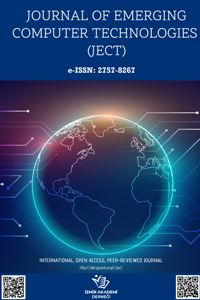A Dynamic Method and Program for Multiple Password Generation and Management
A Dynamic Method and Program for Multiple Password Generation and Management
password, password management, password generation chinese remainder theorem, authentication,
___
- W. A. S. A. Alothman, “Evaluating Passwords User Behavior and the Psychology of Password Management”, International Journal of Engineering and Computer Science, 8(04), 24586–24602, 2019.
- E. Stobert, R. Biddle, “The password life cycle”, ACM Transactions on Privacy and Security (TOPS), 21(3), 1-32, 2018.
- P. Arias-Cabarcos, et. al., “Comparing password management software: toward usable and secure enterprise authentication”, IT Professional, 18(5), 34-40, 2016.
- Y. Y. Choong, “A cognitive-behavioral framework of user password management lifecycle”, In International Conference on Human Aspects of Information Security, Privacy, and Trust, Springer, Cham, 127-137, June 2014.
- E. Stobert, R. Biddle, “Expert password management”, In International Conference on Passwords, Springer, Cham, 3-20, December 2015.
- B. E. Ur, Supporting password-security decisions with data, PhD Thesis, Carnegie Mellon University, 2016.
- C. Shen, et. al., “User practice in password security: An empirical study of real-life passwords in the wild”, Computers & Security, 61, 130-141, 2016.
- A. H. Karp, Site-specific passwords, HP Laboratories, Palo Alto, Tech. Rep., May 2003.
- J. A. Halderman, B. Waters, E. W. Felten, “A convenient method for securely managing passwords”, In Proceedings of the 14th international conference on World Wide Web, 471-479, May 2005.
- R. Wolf, M. Schneider, The passwordsitter, Fraunhofer Institute for Secure Information Technology (SIT), Tech. Rep., May 2006.
- K. P. Yee, K. Sitaker, “Passpet: Convenient password management and phishing protection”, In Proceedings of the second symposium on Usable privacy and security, 32-43, July 2006.
- M. Mannan, P. C. van Oorschot, “Passwords for both mobile and desktop computers: ObPwd for Firefox and Android”, USENIX ;login, 37(4), 28–37, 2012.
- M. Horsch, A. Hülsing, J. A. Buchmann, “PALPAS — passwordless password synchronization”, In 2015 10th International Conference on Availability, Reliability and Security, 30-39, August 2015.
- F. Al Maqbali, C. J. Mitchell, “AutoPass: An automatic password generator”, In 2017 International Carnahan Conference on Security Technology (ICCST), 1-6, IEEE, October 2017.
- A. Abdellaoui, Y. I. Khamlichi, H. Chaoui, “A novel strong password generator for improving cloud authentication”, Procedia Computer Science, 85, 293-300, 2016.
- S. Panda, S. Mondal, “drPass: A Dynamic and Reusable Password Generator Protocol”, In International Conference on Information Systems Security, 407-426, Springer, Cham, December 2018.
- Internet: RndPhrase, https://rndphrase.appspot.com/, 09.11.2021.
- Internet: PwdHash port, https://addons.opera.com/en-gb/extensions/details/pwdhash-port/, 09.11.2021.
- B. Ross, et. al., “Stronger Password Authentication Using Browser Extensions”, In USENIX Security Symposium, 17-32, August 2005.
- Internet: Password generator, https://goo.gl/SNVtJY, 09.11.2021.
- Internet: Lastpass, https://www.lastpass.com/, 09.11.2021.
- Internet: KeePass, https://keepass.info/, 09.11.2021.
- Internet: Dashlane, https://www.dashlane.com/, 09.11.2021.
- Internet: 1Password, https://1password.com/, 09.11.2021.
- P. Arias-Cabarcos et al., “Blended Identity: Pervasive IdM for Continuous Authentication”, IEEE Security & Privacy, 13(3), 32–39, 2015.
- P. Arias-Cabarcos, et. al., “Comparing password management software: toward usable and secure enterprise authentication”, IT Professional, 18(5), 34-40, 2016.
- N. Katuk, et. al., “Can single sign-on improve password management? A focus group study”, Pattern Analysis, Intelligent Security and the Internet of Things, Advances in Intelligent Systems and Computing, 85-93, Springer, Cham, 2015.
- C. Asmuth, J. Bloom, “A modular approach to key safeguarding”, IEEE transactions on information theory, 29(2), 208-210, 1983.
- S. Iftene, “General Secret Sharing Based on the Chinese Remainder Theorem with Applications in E-Voting”, Electronic Notes in Theoretical Computer Science (ENTCS), 186, 67–84, 2007.
- J. C. Patra, A. Karthik, C. Bornand, “A novel CRT-based watermarking technique for authentication of multimedia contents”, Digital Signal Processing, 20, 442-453, 2010.
- S. K. Kim, et. al., “An efficient CRT-RSA algorithm secure against power and fault attacks”, The Journal of Systems and Software, 84(10), 1660-1669, 2011.
- K. Kaya, A. A. Selçuk, “Sharing DSS by the Chinese Remainder Theorem”, Journal of Computational and Applied Mathematics, 259, 495-502, 2014.
- Yayın Aralığı: Yıllık
- Başlangıç: 2021
- Yayıncı: İzmir Akademi Derneği
Face Recognition Based Multifunction IoT Smart Mailbox
Radosveta SOKULLU, Özkan AKIN, Erginay ASLAN
A Dynamic Method and Program for Multiple Password Generation and Management
Onur ÇAKIRGÖZ, Süleyman SEVİNÇ
Digital Twin Based Disaster Management System Proposal: DT-DMS
Özgür DOĞAN, Oğuzhan ŞAHİN, Enis KARAARSLAN
Practical Evaluation on Serious Games in Education
Slavica Mileva EFTİMOVA, Ana Madevska BOGDANOVA, Vladimir TRAJKOVİK
Automatic Movie Rating by Using Twitter Sentiment Analysis and Monitoring Tool
Coding Schemes in 5G Networks for Error-free Communication
Oliver SİMONOSKİ, Ninoslav MARİNA, Natasa DİMOSKA
Coding Schemes for DNA Patient Record Processing to Electronic Health Records Systems
Izabela MİTRESKA, Ninoslav MARİNA, Natasa DİMOSKA
Overview of Techniques and Methods for Stress Recognition
Development of An Efficient Tool to Convert Regular Expressions to NFA
